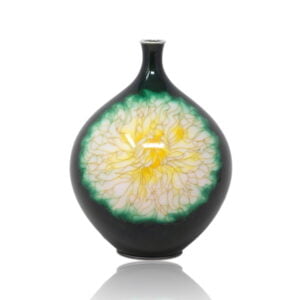Description
Signed to the Base Ryokuzan 緑山
From our Japanese Satsuma Collection, we are delighted to offer this Japanese Satsuma Vase by Ryokuzan 緑山.
The vase is of ovoid form with a tapered body, circular foot rim, waisted neck, and rolled top rim. It is finely decorated with two large panels bordered by gilt chrysanthemums, scrolling vines, and a drip-effect design.
One panel depicts elegant geisha and children beside a torii gate and bridge, set within a landscape of water and foliage. The other shows a riverbank scene with two geese among large blossoming flowers.
The base is signed in gold on a red ground 緑山 (Ryokuzan) beneath the Shimazu clan crest and dates to the Meiji period (1868–1912).
Provenance
Private UK Collection
SHIMAZU MON
The Shimazu Mon (島津紋) is the crest of the Shimazu clan, rulers of the Satsuma domain in southern Japan. The design features a simple cross enclosed within a circle, and it appears on a large number of Japanese Satsuma ware pieces.
Early examples, often dating before the Meiji period, were hand-painted in Gosu blue and are thought to show a direct connection to the Shimazu family. Later versions of the crest, painted in black, gold, or red, do not indicate any official link to the clan and typically date from after the Edo period (1603–1868).
Today, the Shimazu Mon remains one of the most recognisable marks associated with Satsuma ceramics, helping collectors and scholars trace the history and authenticity of individual works.
TORII GATE
A Torii gate (鳥居) is a traditional Japanese structure that marks the entrance to a Shinto shrine, symbolising the transition from the secular world into the sacred. Characterised by two upright pillars supporting a horizontal crossbeam, torii are most often made of wood or stone and frequently painted in vermillion red.
There are several styles, including the straight and simple Shinmei Torii and the more curved Myojin Torii. Some of the most iconic examples are the thousands of gates at Fushimi Inari Taisha in Kyoto and the famous “floating” torii at Itsukushima Shrine on Miyajima Island.
The origins of torii in Japan can be traced back to at least the mid-Heian period, with the earliest written reference dating to 922. The oldest surviving stone torii was built in the 12th century at a Hachiman shrine in Yamagata Prefecture, while the oldest existing wooden example, a ryōbu torii was erected in 1535 at Kubo Hachiman Shrine in Yamanashi Prefecture.
Serving as spiritual thresholds, torii gates remain one of the most recognisable and enduring symbols of Shinto belief and Japanese cultural identity.
MEIJI PERIOD (1868-1912)
The Meiji era marked Japan’s transformation into a modern nation and a golden age of decorative arts. With the end of samurai rule and Japan’s opening to the West, artisans produced works of exceptional quality for both domestic and international audiences. Supported by the government through world fairs and Imperial commissions, Japanese lacquerware, cloisonné, satsuma ceramics, bronzes, and ivory carvings reached collectors worldwide. Many leading artists of the time, including Makuzu Kozan and Namikawa Yasuyuki, were honoured as Imperial Household Artists, ensuring the Meiji period remains one of the most celebrated eras of Japanese art.
For further information please see our article Japanese Meiji Period: Art, Collecting, and Cultural Transformation.
SATSUMA WARE
Satsuma ware originated in southern Kyūshū around 1600 and developed into one of Japan’s most recognisable ceramics. Early Ko-Satsuma pieces were rustic, dark-clay wares made for everyday use, while the later Kyō-Satsuma style became famous worldwide during the Meiji period.
Characterised by ivory crackled glaze, delicate overglaze enamels, and lavish gilding, export Satsuma appealed strongly to Western collectors. Designs often feature landscapes, flowers, figures, and scenes from Japanese life and mythology. Renowned artists such as Yabu Meizan, Ryozan, and the Kinkōzan workshop produced some of the finest examples, which remain highly sought after today. Genuine Satsuma can often be identified by the Shimazu crest, artist signatures, or the mark “Dai Nippon” used during the Meiji era.
For further information on the history of Satsuma Wear please see our article Japanese Satsuma Ware.
MEASUREMENTS
15.5cm High x 7.5cm Diameter (6.1 x 2.95 Inches)
CONDITION
Very Good – some minor rubbing to the faces
With every purchase from Jacksons Antique, you will receive our latest product guides, certificate of authenticity, full tracking information so you can monitor your shipment from start to finish and our personal no-hassle, money-back policy giving you that extra confidence when purchasing. Don’t forget to sign up to our newsletter to receive 10% off your first online purchase with us!


































